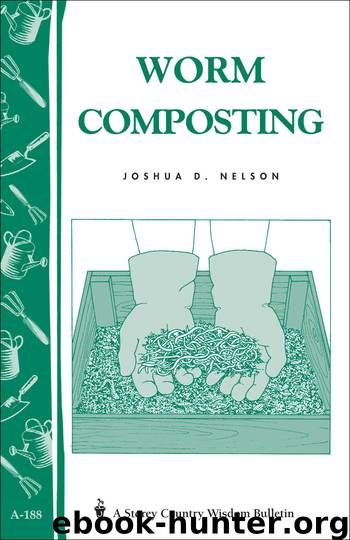Worm Composting by Joshua D. Nelson

Author:Joshua D. Nelson
Language: eng
Format: epub
Publisher: Storey Publishing, LLC
Published: 1998-03-25T16:00:00+00:00
Moving Day: The Thrill of a New Home
What your worms need more than anything when they arrive at their new home is a little peace and privacy. They will explore the confines of their bin and become familiar with their new limits, up and down. It’s a good idea to leave on a light over your indoor worm bin or outdoor system for the first few days. This will deter your worms from wandering off. If you’re setting up an outdoor system, I recommend doing all your setup work in the morning and leaving the lid off for the entire day. This will force the worms to stay within the unit. If it’s too cold or rainy to leave off the lid, you may want to attach a light to the inside of the lid to keep the worms comfortable and inside.
Fill the bin to within a couple of inches (5 cm) of the top with your selected bedding. Don’t pack it down; the worms would be unable to move. Then dump in your worms.
Begin adding kitchen scraps. The simplest way to do this is to mentally split your bin into three zones. For example, if your bin is 24″ by 16″ long, each zone will be about 8″ wide and 16″ long. When you have kitchen scraps, starting at the left side of your bin and moving right (or whatever system you’ll remember), dig a furrow down the length of zone 1, making it just deep enough to accommodate the food and a layer of bedding on top. Add the waste to the furrow, then add the bedding you dug out of the furrow on top to bury it. The worms will be attracted by the presence of moist, rich food. A few days later, when you have more scraps, repeat in the next zone, then in the third zone. Then start over again.
You will notice eventually that the content of your bin has been reduced, and you can no longer see much of the bedding. This means the worms are working and happy and you have your first crop of vermicompost. You now have to remove the vermicompost, because castings left in the bin are actually toxic to your worms and will eventually kill them if not removed. To clean out the bin, you must sort the compost from the worms.
Download
This site does not store any files on its server. We only index and link to content provided by other sites. Please contact the content providers to delete copyright contents if any and email us, we'll remove relevant links or contents immediately.
Turbulence by E. J. Noyes(7942)
The Thirst by Nesbo Jo(6832)
Gerald's Game by Stephen King(4584)
Be in a Treehouse by Pete Nelson(3954)
Marijuana Grower's Handbook by Ed Rosenthal(3623)
The Sprouting Book by Ann Wigmore(3546)
The Red Files by Lee Winter(3368)
The Remains of the Day by Kazuo Ishiguro(3296)
Sharp Objects: A Novel by Gillian Flynn(2958)
Christian (The Protectors Book 1) by L. Ann Marie(2656)
Organic Mushroom Farming and Mycoremediation by Tradd Cotter(2631)
The Culinary Herbal by Susan Belsinger(2433)
Stone Building by Kevin Gardner(2353)
The Starter Garden Handbook by Alice Mary Alvrez(2285)
Lilac Girls by Martha Hall Kelly(2258)
The Unlikely Pilgrimage of Harold Fry by Rachel Joyce(2222)
The Lean Farm Guide to Growing Vegetables: More In-Depth Lean Techniques for Efficient Organic Production by Ben Hartman(2099)
Urban Farming by Thomas Fox(2063)
Backyard Woodland by Josh VanBrakle(1896)
